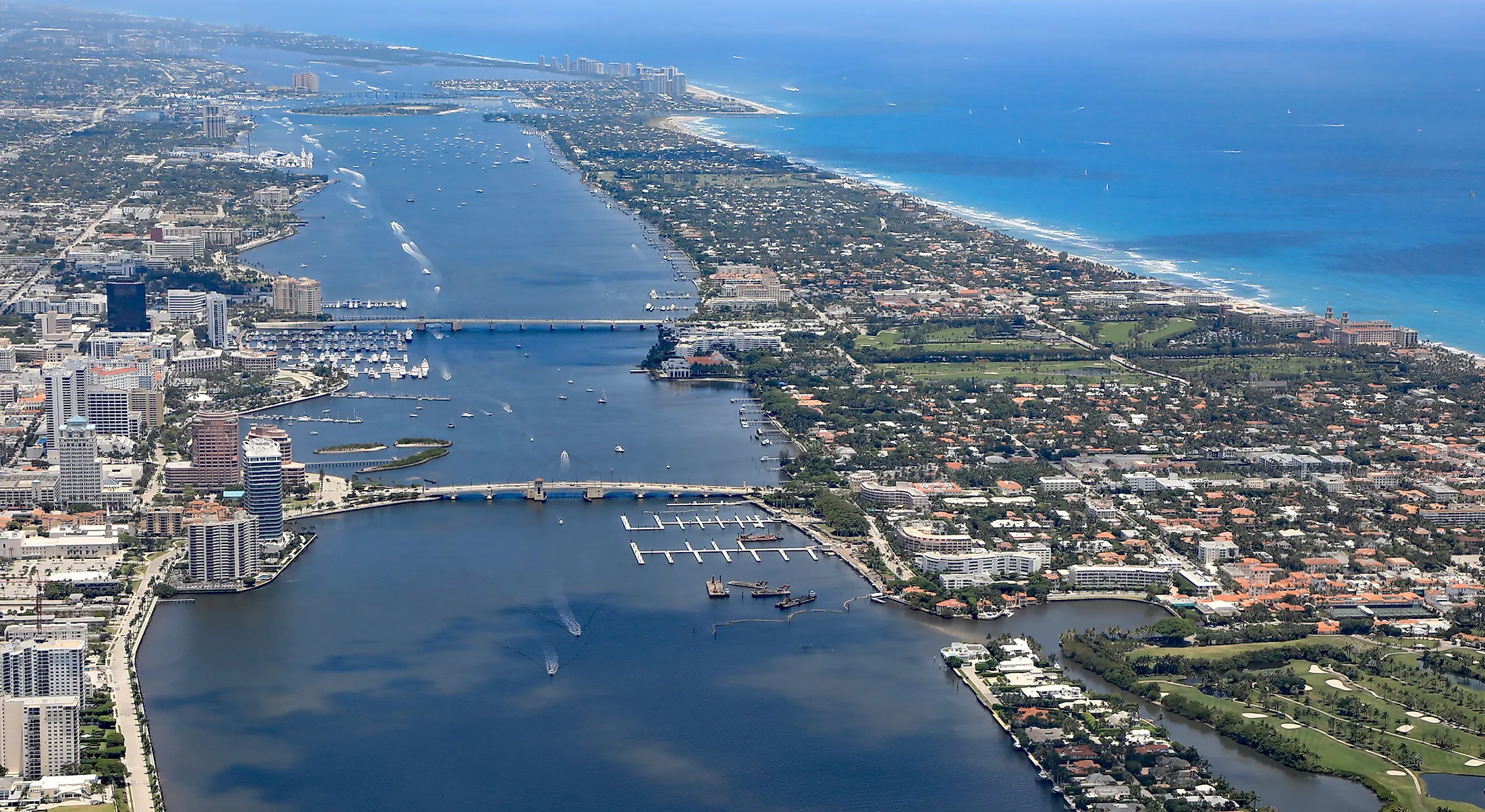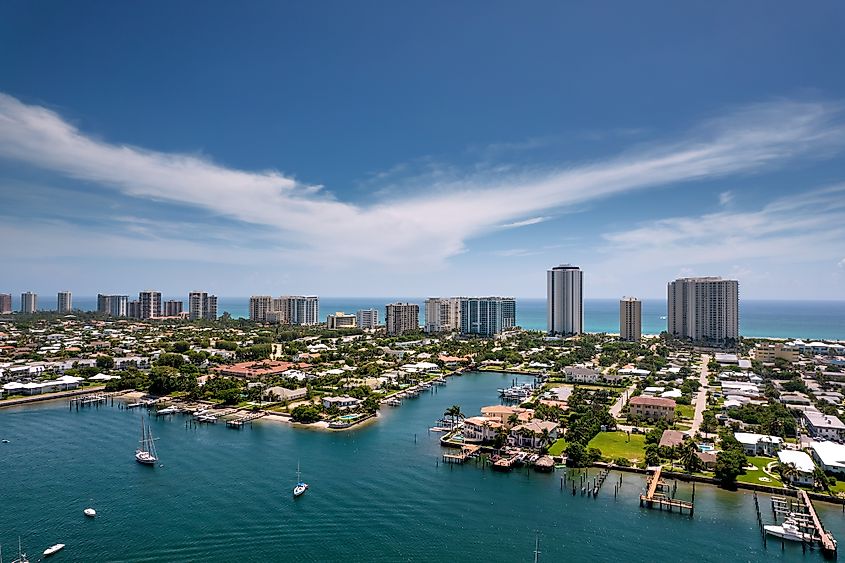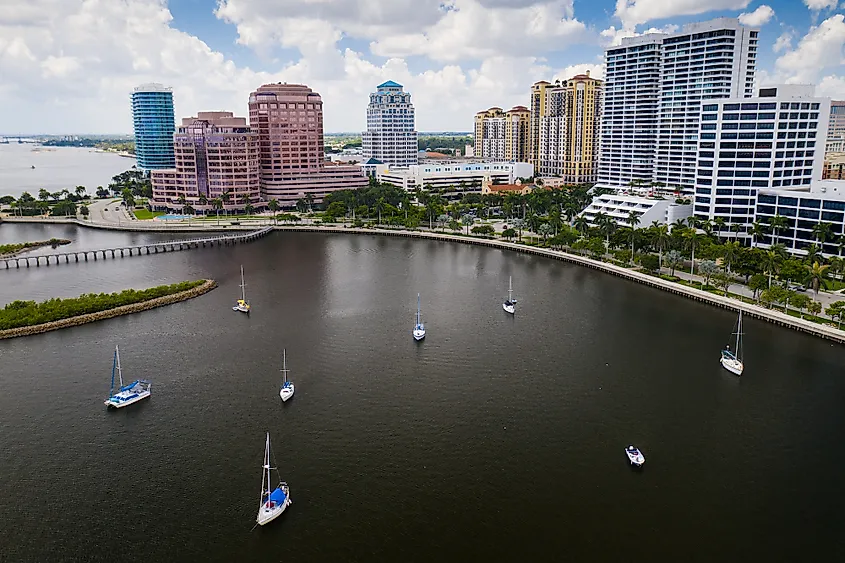
Lake Worth Lagoon
Lake Worth Lagoon is a 34km long lagoon situated on the Atlantic Coast in the Palm Beach County of the US State of Florida. The lagoon is located approximately 85.29km south of Ft. Pierce Harbor, 64.37km north of Port Everglades, and 104.6km north of Miami Harbor. The lagoon has been named in honor of the American officer William Jenkins Worth, who served as a military commander during the Second Seminole War.
Geography Of Lake Worth Lagoon

Running parallel to the coast, the Lake Worth Lagoon has a maximum width of about 1.6km and reaches a maximum depth of 2.43m. This shallow body of water is separated from the Atlantic Ocean by two barrier islands, namely the Singer Island and Palm Beach Island. The lagoon is connected to the ocean by two permanent artificial inlets: the Lake Worth Inlet and the South Lake Worth Inlet. The Lake Worth or the Palm Beach Inlet connects the northern portion of the Lake Worth Lagoon with the Atlantic Ocean. This inlet is, in turn, bordered by the Floridian towns of Palm Beach Shores in the north and Palm Beach in the south. The Lake Worth Inlet is a federally maintained deep draft inlet that also serves as the entrance channel to the Port of Palm Beach. The South Lake Worth or the Boynton Inlet, located about 29.7km south of Lake Worth Inlet, connects the southern end of the Lake Worth Lagoon with the Atlantic Ocean. This 40m wide inlet is bordered by the Floridian towns of Ocean Ridge in the south and Manalapan in the north. Recreational boaters mainly use the South Lake Worth Inlet. The Intracoastal Waterway runs along the entire length of the lagoon.
The Lake Worth Lagoon provides essential habitat for various plants, fish, and wildlife populations, offering a wide range of recreational activities. The Lake Worth Inlet also provides an inland to coastal marine-connected system where juvenile marine animals hatch before moving out into the ocean. At present, about eight causeways and bridges connect the mainland to the barrier islands, and bulkheads line approximately 81% of the lagoon’s shoreline. Rapid urbanization in the surrounding area had led to the clearing of mangroves that once lined a significant part of the shoreline. It has also been found that untreated stormwater from the surrounding urban areas also drains into the lagoon. Numerous marinas, the Port of Palm Beach, and a power plant that has been built on the shores also lead to an increase in pollution of the Lake Worth Lagoon.
Brief History Of Lake Worth Lagoon

Records indicate that in the mid-19th century, the Lake Worth Lagoon was a landlocked freshwater lake. No rivers or streams flowed into the lake, and the lake received water only by ground seepage from the Everglades. The lake served as an essential source of fresh water along the east coast. It also provided a refuge for the wildlife and the indigenous peoples with food, water, and transportation facilities. The native Seminoles referred to the lake as “Hypoluxo,” which meant “water all around, no get out” and referred to the landlocked condition of the lake. Some temporary inlets occasionally formed during extreme high tides and high lake water levels but quickly closed again. Eventually, these ephemeral ocean linkages were made permanent through dredging and channel protection structures. In the 1860s, a settler named August O. Lang had dug a narrow trench from the Atlantic Ocean to Lake Worth, and this cut helped in draining the lake down to sea level.
The continued freshwater seepage from the Everglades, along with the limited ocean water inflow from the inlet, made the lake mildly brackish. However, the Lang’s inlet was highly unstable and had to be re-dug several times. In 1877, the channel was relocated to a rocky area at the Black Rocks situated about 1.6km from Lang’s Inlet. As a result, the lake changed from a freshwater lake to a saltwater lagoon. In 1880, the completion of the construction of a navigation canal from the northern end of the Lake Worth Lagoon to the Jupiter Inlet led to an increase in freshwater discharges into the lagoon.
The construction of the Atlantic Intracoastal Waterway was completed in the early 1900s, from the southern end of the Lake Worth Lagoon to the Biscayne Bay. A permanent inlet of about 1.22m deep at the original location of the Lang’s Inlet was created by the Port of Palm Beach in 1915. In 1925, this inlet was further deepened to about 4.9m. To provide flushing towards the southern end of the Lake Worth Lagoon and improve tidal circulation, the South Lake Worth Inlet was constructed in 1917. The construction of the West Palm Beach Canal in 1925 also resulted in significant freshwater inflow to the Lake Worth Lagoon. In the mid-1990s, the lake’s deteriorating health led the Department of Environmental Resources Management of Palm Beach County to implement the “Lake Worth Lagoon Management Plan” for the lagoon’s habitat restoration, enhancement, and water quality improvements.











